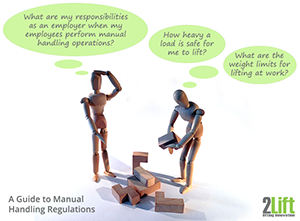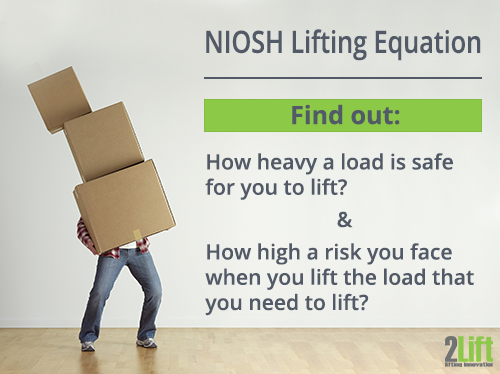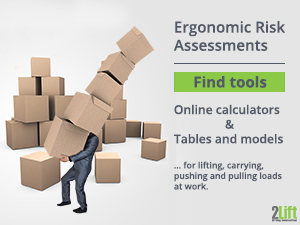Risk Assessment UK
- Manual Handling Regulations and Ergonomic Risk Assessment Tools for the United Kingdom
If you live in the United Kingdom and are looking for ergonomic guidelines and UK risk assessment tools for the manual handling of loads, you're in luck.
As a result of our research, we are tempted to say that in the EU (here before Brexit when the UK is still part of the EU), the UK probably has the largest amount of online material available for British employers seeking information on ergonomics and manual handling.
Aside from general information pertaining to manual handling in the UK, we will provide you with links to find, among other things:
- Employer guidelines on how to comply with the regulations for the manual handling of loads.
- Ergonomic risk assessment tools for lifting, lowering, carrying, pushing and pulling.
But before diving into details of rules and regulations, let's take a helicopter view to see how everything is strung together in the UK.
HSE: The Authority Responsible for the Field of Manual Handling in UK
The UK has one of the longest recorded traditions for protecting people at work with roots going all the way to the 19th century.
In the UK, EU-OSHA's national focal point is administered by the Health and Safety Executive (HSE), and is supported by HSE Northern Ireland (HSENI) and work together with various other national / social organizations and government departments.
HSE describes themselves as an "independent regulator for work-related health, safety and illness." In other words, HSE is the agency responsible for setting the strategy and legal framework for everything health and safety-related in the UK, including that of manual handling.
HSE's work consists, among other things, of creating public material for employers, so they can understand the level of risk to which they subject their workers, and how they may go about eliminating those risks.
Ergonomic Manual Handling Guidelines in the UK for Employers
 The most important document for employers to orientate themselves in is the HSE publication: Manual handling. Manual Handling Operations Regulations 1992. This document provides guidance for employers to help them identify, manage and reduce / eliminate the risks from the manual handling of loads at work.
The most important document for employers to orientate themselves in is the HSE publication: Manual handling. Manual Handling Operations Regulations 1992. This document provides guidance for employers to help them identify, manage and reduce / eliminate the risks from the manual handling of loads at work.
The manual handling tasks that you can read about are: lifting, lowering, carrying, pushing and pulling.
The employer guidelines to the manual handling of loads comes in two versions:
 In order to comply with the manual handling regulations, you as an employer need to go through the following steps:
In order to comply with the manual handling regulations, you as an employer need to go through the following steps:
- avoid the need for hazardous manual handling, ‘so far as is reasonably
practicable’;
- assess the risk of injury from any hazardous manual handling that can’t be
avoided;
- reduce the risk of injury from hazardous manual handling, ‘so far as is
reasonably practicable’.
Often step number one isn't quite possible, which makes risk assessment a necessary second step. If these risk assessments 'fail' (meaning there is a risk of injury), you need to consider other options such as mechanical aids.
How to See if Your Manual Handling Tasks Are Considered Safe and Healthy
As you will discover in the above mentioned documents, manual handling is more than just weight limits. There are many other important risk factors to take into account, and that's the reason why ergonomic risk assessments often get very complicated.

Here is a quick explanation of how it works with weight limits and force factors:
In most models there is an ideal (the most healthy way) way to carry out a lifting, lowering, pushing, pulling or carrying operation. That ideal creates a baseline with the heaviest recommended load or highest push and pull factors. If the manual handling task becomes more complicated (less ideal for the body), the recommended weight load and force factors will be reduced.
For instance if you need to twist your trunk to grab an object at head height far away from the body, it shouldn't be nearly as heavy as one taken with a straight spine close to the body at hip height.
In the UK, the maximum recommended load for the ideal lifting and lowering task (close to the body at hip height) is:
- 25 kg for men.
- 16 kg for women.
Thus, when other other factors come into play, such as e.g. trunk twisting and high lifting and lowering frequency, the recommended weight of the load should be reduced by certain percentage.
Below you'll find the maximum force for pushing and pulling under ideal circumstances (e.g. level floors/no sloping etc).
 In the UK, the maximum recommended force to stop or start the load is:
In the UK, the maximum recommended force to stop or start the load is:
- 20 kg for men (app. 200 newtons).
- 15 kg for women (app. 150 newtons).
In the UK, the maximum sustained force to keep the load in motion is:
- 10 kg for men (app. 100 newtons).
- 7 kg for women (app. 70 newtons).
UK Risk Assessment Tools for the Manual Handling of Loads
All depending on the complexity of manual handling tasks, in the UK there are different ergonomic risk assessment tools you can use to find out if you are providing safe working conditions for your employees.
The ergonomic tools are:
Weight Filter Models for how Much You May Lift under Ideal Circumstances
Simple weight filter models for manual handling that is e.g. symmetrical and infrequent. You will e.g. find one page 54 in Manual handling. Manual Handling Operations Regulations 1992. (It is very similar to our Manual Handling Weight Lifting Limits model above).

The Mac Tool for Lifting and Carrying at Work
A more comprehensive risk assessment can be performed using e.g. HSE's MAC tool. The MAC tool (The Manual Handling Assessment Charts) is a mostly used as a professional tool by safety and health managers, representatives and inspectors to identify manual handling operations that constitute a high risk.
The MAC tool can be used for lifting tasks, carrying tasks, and team handling operations.
The MAC risk assessment section consists of a guide, a flow chart and a score sheet.
If the lifting operation includes loads where the weight varies, you can use the MAC tool in combination with the V-MAC tool. ("V" is for Variable.)
 The ART Tool for Upper Limbs Repetitive Tasks
The ART Tool for Upper Limbs Repetitive Tasks
If the manual handling tasks are characterized by repetitiveness involving the upper limbs, the HSE also has a risk assessment tool for this called the ART tool (Assessment of Repetitive Tasks).

RAPP Tool for Pushing and Pulling at Work
Finally, if your manual handling tasks consist of pushing and pulling, you'll find the RAPP tool ideal for that.
Full Risk Assessment UK
A full manual handling risk assessment sheet with examples of how to fill it out: This full risk assessment can either be carried out on its own or in combination with the other risk assessment tools.
Online Resources from HSE: Ergonomic Assessment Tools and Guidelines in the UK

Special Copyright Notice
This page contains public sector information published by the Health and Safety Executive, which is licensed under the Open Government Licence. This notice applies to the illustrations for the following HSE publications: Manual handling. Manual Handling Operations Regulations 1992, Manual handling at work. A brief guide, the Mac Tool, the Art Tool and the Rapp Tool.
Information Disclaimer
We have done our very best to ensure the accuracy and reliability of the information presented on this page. However, we cannot guarantee the correctness of any information (regulations change from time to time, responsibilities change hands, etc.). Thus we cannot accept any responsibility or liability for the accuracy, content, completeness, legality, or reliability of the information provided here.
If, however, you are aware of any outdated or incorrect information on this page, you are very welcome to contact us, so we can bring our page up to date.
Other Pages on Manual Handling Regulations

Manual Handling Regulations Guide |

The NIOSH Lifting Equation |

Ergonomic Risk Assessment Tools |
Country Specific Pages with Ergonomic Guidelines and Risk Assessment Tools

UK |

Germany |

Austria |

France |

Ireland |

The Netherlands |

Denmark |

Sweden |

Spain |

Portugal |

Italy |

Switzerland |

Norway |

Canada |

Australia |
|
|
|